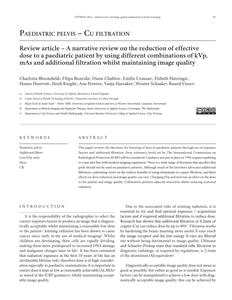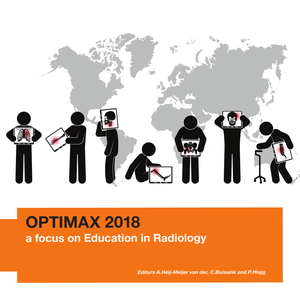Purpose: To determine whether using different combinations of kVp and mAs with additional filtration can reduce the effective dose to a paediatric phantom whilst maintaining diagnostic image quality.Methods: 27 images of a paediatric AP pelvis phantom were acquired with different kVp, mAs and additional copper filtration. Images were displayed on quality controlled monitors with dimmed lighting. Ten diagnostic radiographers (5 students and 5 experienced radiographers) had eye tests to assess visual acuity before rating the images. Each image was rated for visual image quality against a reference image using 2 alternative forced choice software using a 5-point Likert scale. Physical measures (SNR and CNR) were also taken to assess image quality.Results: Of the 27 images rated, 13 of them were of acceptable image quality and had a dose lower than the image with standard acquisition parameters. Two were produced without filtration, 6 with 0.1mm and 5 with 0.2mm copper filtration. Statistical analysis found that the inter-rater and intra-raterreliability was high.Discussion: It is possible to obtain an image of acceptable image quality with a dose that is lower than published guidelines. There are some areas of the study that could be improved. These include using a wider range of kVp and mAs to give an exact set of parameters to use.Conclusion: Additional filtration has been identified as amajor tool for reducing effective dose whilst maintaining acceptable image quality in a 5 year old phantom.
DOCUMENT

This paper reviews the literature for lowering of dose to paediatric patients through use of exposure factors and additional filtration. Dose reference levels set by The International Commission on Radiological Protection (ICRP) will be considered. Guidance was put in place in 1996 requires updatingto come into line with modern imaging equipment. There is a wide range of literature that specifies that grids should not be used on paediatric patients. Although much of the literature advocates additional filtration, contrasting views on the relative benefits of using aluminium or copper filtration, and theireffects on dose reduction and image quality can vary. Changing kVp and mAs has an effect on the dose to the patient and image quality. Collimation protects adjacent structures whilst reducing scattered radiation.
DOCUMENT

Abstract gepubliceerd in Elsevier: Introduction: Recent research has identified the issue of ‘dose creep’ in diagnostic radiography and claims it is due to the introduction of CR and DR technology. More recently radiographers have reported that they do not regularly manipulate exposure factors for different sized patients and rely on pre-set exposures. The aim of the study was to identify any variation in knowledge and radiographic practice across Europe when imaging the chest, abdomen and pelvis using digital imaging. Methods: A random selection of 50% of educational institutes (n ¼ 17) which were affiliated members of the European Federation of Radiographer Societies (EFRS) were contacted via their contact details supplied on the EFRS website. Each of these institutes identified appropriate radiographic staff in their clinical network to complete an online survey via SurveyMonkey. Data was collected on exposures used for 3 common x-ray examinations using CR/DR, range of equipment in use, staff educational training and awareness of DRL. Descriptive statistics were performed with the aid of Excel and SPSS version 21. Results: A response rate of 70% was achieved from the affiliated educational members of EFRS and a rate of 55% from the individual hospitals in 12 countries across Europe. Variation was identified in practice when imaging the chest, abdomen and pelvis using both CR and DR digital systems. There is wide variation in radiographer training/education across countries.
DOCUMENT

This year, OPTIMAX was warmly welcomed by University College Dublin. For the sixth time students and teachers from Europe, South Africa, South America and Canada have come together enthusiastically to do research in the Radiography domain. As in previous years, there were several research groups consisting of PhD-, MSc- and BSc students and tutors from the OPTIMAX partner Universities or on invitation by partner Universities. OPTIMAX 2018 was partly funded by the partner Universities and partly by the participants.
DOCUMENT
